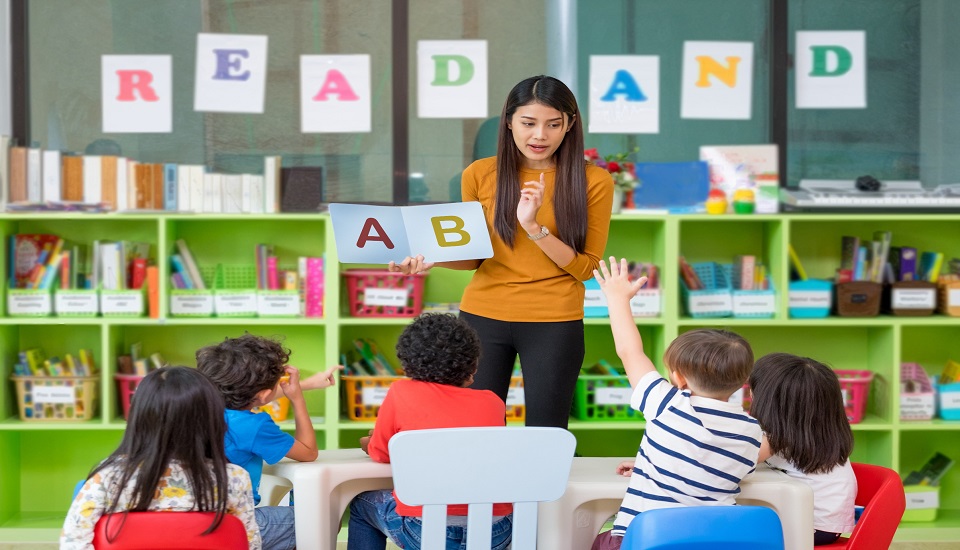Nurturing Inner Peace: 7 Effective Ways Of Teaching Self-Calming Skills In The Classroom To Your Preschoolers
5th February 2024
We live in a competitive and fast-paced world where from a young age children have to strive for the best to achieve academic success and in their other fields of life as well. Apart from this, students also feel challenges like- hardship, personal loss, feelings of exclusion, or any emotional turmoil that could raise feelings of stress and anxiety among them.
Looking at the circumstances, it’s every educator's responsibility to equip their students to deal with challenging circumstances and feelings effectively. One of the effective skills that every educator should consider teaching is "self-calming skills".
Teaching self-calming skills in the classroom will equip students to regulate their feelings and behaviour in a healthy manner.
Let’s get to explore, some of the effective ways of teaching self-calming skills in the classroom which any educator, principal, and school teacher can use straight away.
Before moving to the topic, can we ask you a question? Do you follow us on Social Media? We regularly share upgraded educational content, tips, feedback, and more. Check us out by clicking the profiles here - Facebook / Twitter / LinkedIn / Pinterest / Instagram / YouTube
So, without any further delay, let’s get started.
Importance of Self-Calming Activities For Preschoolers
Self-calming skills is one of the vital skills for your preschoolers because it helps them to develop emotional intelligence, which ultimately helps them to regulate their emotions and behaviours.
Self-calming skills help children to balance their emotions, manage their emotional responses, and even improve their overall emotional and mental health.
Additionally, it also helps young learners to improve their social interactions and also makes them equipped to deal with any upcoming academic challenges and pressure effectively.
Effective Ways of Teaching Self-Calming Skills In The Classroom
1. Teaching Emotional Recognition
One of the first steps in managing emotions effectively is the ability to recognize different emotions. You must help your preschoolers recognize and name their emotions, which is a vital step in regulating emotions in a healthier way.
You can utilize various visual aids and resources like- emotions charts or you can conduct one-on-one sessions where they can share their feeling and thoughts freely.
2. Mindfulness Activities
One of the most effective calming activities for preschoolers is mindfulness. It helps your preschoolers to be at the present moment and become aware of their ongoing feelings and thoughts without any judgments. Let’s get to know a few mindfulness exercises for kids to calm down:
- Breathing Exercise: You can instruct your preschoolers to focus on their breath and notice the inhaling and exhaling air from their chest, which brings their focus to the present and avoids any negative thoughts or feelings.
- Mindful Listening Exercise: You can encourage them to spend time in an open environment that is full of greenery around them like the park. This will bring their focus to the present moment and they start to appreciate the environment around them.
3. Encourage Participation in Physical Activities
Involvement in various physical activities can prove to be beneficial for preschoolers to manage their anxiety, stress, and any negative emotions and thoughts they are having. You can encourage them to be involved in activities like- yoga, dance, or even simple exercises that can help your preschoolers to relax and calm their mind and body.
How mindfulness plays an important role in Early Childhood Environment
4. Encourage Participation in Muscle Relaxation Activities
Muscle relaxation activities can help your young learners mitigate the physical symptoms of stress like- difficulty in breathing, panic attacks, fatigue, or sleep problems. You can encourage them in muscle relaxation activities like-
- Guide them to tense their shoulder and chest then relax them.
- Guide them to tense their hands then relax them.
- Guide them to tense their legs then relax them.
5. Utilize Story-Telling & Role-Playing Methods
One of the best ways to teach self-calming skills to your young learners is by using story-telling and role-playing techniques. You can read books about emotions and self-regulation for children, which has characters who deal with various emotions and how they deal with them.
Books you can consider like-
- Emotion Regulation in Children and Adolescents: A Practitioner's Guide
- I'm Just a Kid: A Social-Emotional Book about Self-Regulation
- My Body Sends a Signal: Helping Kids Recognise Emotions and Express Feelings
6. Create a Dedicated Calming Corner
As a responsible educator, you must focus on creating a calm down corner in preschool where your young learners can practice self-calming activities. In this calming corner, you can consider adding stress balls, soft pillows, and various calm-down prompts around the dedicated space.
7. Engage Preschooler’s Parents or Care-Giver
Young learners spend most of their time other than school in their own homes. So, it’s better to involve their parents and caregivers. You can share all the strategies or resources that you have made for teaching self-calming skills in the classroom with their parents and care-giver so they can use them to help children even at home to manage and regulate their emotions and behaviour effectively.
Self-Calming Skill is the Key to Young Learners Overall Well-Being
Teaching Self-Calming skills in the classroom to your preschoolers is one of the essential steps to ensure their emotional and physical well-being. To make preschoolers' lives simpler, you can consider incorporating all the above-mentioned strategies to help children learn various self-calming methods and activities.
Also, consider pursuing courses like Live Online International Teaching Diploma Course, which will help you to understand your young learner's emotional state and different ways to equip them with various self-calming skills to deal with their emotions and thoughts effectively.
We believe education should be accessible for everyone. That’s why we don’t charge for our blogs. Find the right course that will help you in your career with us, contact us at - 1800–212–6400. You can mail us at act@asiancollegeofteachers.com.
Written By : Abhishek
Leave a Reply

